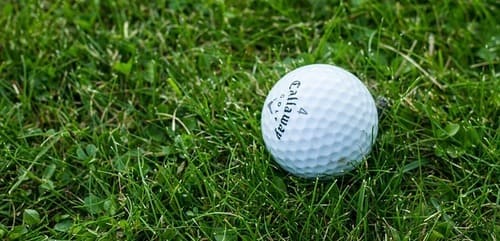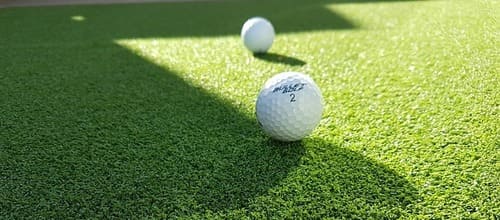Golf ball numbering is a system used to differentiate and identify different types of golf balls. Each golf ball is marked with a unique number consisting of one or two digits. These numbers hold significance as they provide valuable information about the ball’s characteristics and performance. Understanding these numbers is essential in choosing the right golf ball for your game.
Golf Ball Numbering Explained
The digits on golf balls typically range from 0 to 99. The most common numbering system used is between 1 and 4, with 1 being the softest and offering the most spin, and 4 being the hardest and providing the least spin.
Additionally, some golf balls may have a double-digit number, such as 23 or 47. These double-digit numbers often indicate a specific model or version of a golf ball, with each number representing a different variation in technology or design.
By familiarizing yourself with the different digits on golf balls, you can make an informed decision about which ball is best suited for your playing style and preferences.
The Importance of Golf Ball Numbers
When it comes to golf ball numbers, understanding their importance is essential for every golfer. The digits on a golf ball serve a significant purpose in determining its characteristics and performance. Whether you are a professional golfer or a casual player, knowing the significance of golf ball numbers can make a difference in your game.
The first key aspect is comprehending the sequence of digits on a golf ball. These numbers typically range from 1 to 4 or 5, with the most common being 1, 2, 3, and 4. Each number signifies different attributes, such as compression, spin, distance, and trajectory.
By paying attention to the golf ball’s number, golfers can make informed decisions based on their desired playing style and preferences.
Additionally, the golf ball number plays a crucial role in customizing one’s game. Golfers can tailor their equipment to meet their specific needs by choosing a ball number that complements their swing speed, spin control, or overall performance requirements.
Understanding the importance of golf ball numbers empowers golfers to make deliberate choices that can enhance their game.
Understanding the Different Digits on Golf Balls
Golf ball numbering can be confusing for many players, but understanding the different digits on golf balls is essential for making an informed choice. The numbering system usually consists of a combination of one or two numbers, followed by a letter.
The first number typically indicates the compression rating of the ball, ranging from 0 to 200. Higher compression balls are ideal for players with faster swing speeds, as they provide more control and distance.
Conversely, lower compression balls are more suitable for players with slower swing speeds, as they offer more forgiveness and a softer feel.
The second number on golf balls represents the number of dimples or the dimple pattern. Dimples play a crucial role in aerodynamics, maximizing lift and reducing drag as the ball soars through the air.
Generally, golf balls with more dimples tend to fly higher and have greater spin, while those with fewer dimples produce a lower trajectory and less spin. It’s important to note that the optimal dimple pattern and number may vary depending on individual preferences and playing conditions.
By understanding these key digits, golfers can make more informed decisions when selecting the right golf ball for their game.
Decoding the Meaning behind Golf Ball Numbers
When looking at the digits on golf balls, it may initially seem like a random assortment of numbers. However, these numbers actually hold a significant meaning. The first digit typically represents the brand or manufacturer of the golf ball. For instance, if the first digit is a “1,” it could indicate that the ball was manufactured by Titleist. Likewise, a “2” might be associated with a Callaway ball. These numbers serve as identifiers, helping golfers easily recognize the brand of the ball they are playing with.
In addition to the brand identification, the remaining digits on a golf ball can provide insights into its specific characteristics. The second digit can denote the model or type of the ball, indicating whether it is designed for distance, control, or feel. The final two digits often represent the compression rating of the ball, which affects its firmness and responsiveness.
Golfers who prefer a softer feel might opt for a ball with lower compression, while those looking for more distance and control might choose a higher compression ball. By deciphering the meaning behind these numbers, golfers can gain a better understanding of the performance attributes each ball offers, ultimately helping them make informed decisions on which type of golf ball to use.

How Golf Ball Numbers Affect Performance
Golf ball numbers have a significant impact on the performance of a golfer. The numbers on a golf ball, typically ranging from 1 to 4, are not just there for decoration but serve a specific purpose. Each digit on the ball represents different characteristics that affect the way it performs when struck by a club.
For instance, the number on a golf ball can determine factors such as distance, trajectory, spin, and compression. It is important for golfers to understand the significance of these numbers and how they can optimize their performance on the golf course.
The first digit on a golf ball, typically ranging from 1 to 4, represents its compression rating. The compression of a golf ball refers to how tightly the ball is packed or how much it compresses upon impact. A lower compression ball, indicated by the number 1, is softer and tends to compress more, providing golfers with a softer feel and additional distance.
On the other hand, higher compression balls, such as those with the number 4, are firmer and compress less, resulting in more control and accuracy. Determining the optimal compression rating is crucial for golfers seeking to enhance their performance and achieve desired results.
The Relationship between Golf Ball Numbers and Compression
Golf ball numbers and compression are closely intertwined in the world of golf. In fact, the number on a golf ball can reveal valuable information about its compression rating. Compression refers to the density of the ball and its ability to compress upon impact with the clubface. Generally, golf balls come in two compression categories: low compression and high compression.
Low compression golf balls have a lower number, typically ranging from 50 to 70. These balls are designed for golfers with slower swing speeds, as they compress easily upon impact, thus maximizing distance. On the other hand, high compression golf balls have a higher number, usually between 80 and 100. These balls are geared towards golfers with faster swing speeds, as they require greater force to compress and generate more control and accuracy.
Understanding the relationship between golf ball numbers and compression is crucial in optimizing a golfer’s performance. Selecting the right compression rating can have a significant impact on achieving the desired distance and control in each shot. It is important for golfers to assess their swing speed and choose a golf ball with a corresponding compression rating that suits their individual playing style.
By finding the perfect balance between golf ball numbers and compression, golfers can expect improved performance on the course.
Exploring the Impact of Golf Ball Numbers on Spin
The spin of a golf ball plays a crucial role in the game, as it directly affects the ball’s trajectory and control. When exploring the impact of golf ball numbers on spin, it is important to understand how the numbers themselves correlate with spin characteristics. The numbers typically found on golf balls range from 0 to 9, with variations in patterns and placement. While there is no universal standard for relating these numbers to spin, certain patterns can be observed.
One of the key factors influencing spin is the dimple pattern on the golf ball’s surface, which can vary depending on the manufacturer and model. Generally, golf balls with higher numbers tend to have a higher dimple count. This higher number of dimples contributes to increased spin, as it creates more turbulence in the airflow around the ball.
Additionally, the surface texture and material composition of the ball can also impact spin. For example, softer cover materials may generate more friction with the clubface, resulting in greater backspin. However, it is essential to keep in mind that other factors, such as swing speed and strike quality, can also significantly influence spin.
The Connection between Golf Ball Numbers and Distance
The distance a golf ball can cover is greatly influenced by its number. In general, golf balls with lower numbers tend to travel farther than those with higher numbers. This is because lower-numbered balls are designed to have less spin, resulting in a lower trajectory and increased roll. The reduced spin also allows the ball to maintain its speed and carry more efficiently through the air. Consequently, these balls are ideal for golfers who prioritize distance off the tee.
On the other hand, higher-numbered golf balls are generally designed to generate more spin. This increased spin can be beneficial for golfers who require additional control and the ability to shape their shots. However, the added spin tends to reduce the ball’s overall distance capabilities.
Consequently, golfers who prioritize accuracy and feel around the greens may opt for higher-numbered balls to maximize control over distance.

Analyzing the Role of Golf Ball Numbers in Trajectory
Golf ball numbers play a significant role in determining the trajectory of a shot. The number on a golf ball represents its dimple pattern, which directly affects its flight characteristics. In general, golf balls with lower numbers, such as 1 or 2, have fewer and larger dimples, resulting in a lower trajectory.
On the other hand, golf balls with higher numbers, such as 4 or 5, have more and smaller dimples, leading to a higher trajectory.
The dimple pattern of a golf ball influences the lift and drag forces acting on it during flight. Golf balls with fewer and larger dimples create more drag, reducing the lift and causing a lower trajectory. Conversely, golf balls with more and smaller dimples create less drag, allowing for greater lift and resulting in a higher trajectory.
By understanding and analyzing the relationship between golf ball numbers and trajectory, golfers can make informed choices when selecting the right ball for their game.
Factors to Consider when Choosing the Right Golf Ball Number
The first factor to consider when choosing the right golf ball number is your swing speed. Different golf ball numbers are designed to optimize performance for different swing speeds. Generally, golf ball numbers with lower digits are better suited for players with higher swing speeds, while higher digit numbers are ideal for players with slower swing speeds. This is because lower digit golf balls tend to have a higher compression, allowing them to transfer energy more efficiently and generate more distance for high swing speed players.
On the other hand, higher digit golf balls have a lower compression, which helps players with slower swing speeds to compress the ball and achieve optimal distance.
Another factor to consider is your trajectory preferences. Golf ball numbers can affect the trajectory of your shots by influencing the amount of spin you generate. Lower digit golf balls, such as those with numbers 1, 2, or 3, generally produce less spin, resulting in a lower ball flight with less curve. These are often preferred by golfers looking for a more penetrating trajectory.
On the other hand, higher digit golf balls, like those with numbers 5 or 6, tend to generate more spin, leading to a higher ball flight and greater ability to shape shots. If you have a preference for a specific trajectory or shot-shaping capabilities, considering the golf ball number becomes crucial in your selection process.
FAQs
What are golf ball numbers and why are they important?
Golf ball numbers refer to the digits or markings on the golf ball. They are important because they provide information about the ball’s characteristics and can affect its performance.
How can I understand the different digits on golf balls?
The digits on golf balls typically range from 1 to 4. Each number is associated with specific characteristics, such as compression, spin, distance, and trajectory. Understanding these characteristics can help you choose the right golf ball for your game.
How do golf ball numbers affect performance?
Golf ball numbers can affect performance by influencing factors such as compression, spin, distance, and trajectory. Different numbers have different characteristics, so choosing the right number can enhance your game.
What is the relationship between golf ball numbers and compression?
Golf ball numbers are often related to compression. Lower numbers (e.g., 1 and 2) indicate lower compression, while higher numbers (e.g., 3 and 4) indicate higher compression. Compression affects how the ball reacts upon impact and can impact distance and feel.
How do golf ball numbers impact spin?
Golf ball numbers can influence spin. Lower numbers tend to generate less spin, while higher numbers tend to generate more spin. Spin affects control and maneuverability of the ball.
Is there a connection between golf ball numbers and distance?
Yes, golf ball numbers can impact distance. Generally, lower numbers (1 and 2) are associated with longer distances, while higher numbers (3 and 4) are associated with shorter distances due to their compression characteristics.
How do golf ball numbers affect trajectory?
Golf ball numbers can affect trajectory. Lower numbers (1 and 2) tend to produce a lower trajectory, while higher numbers (3 and 4) tend to produce a higher trajectory. Trajectory can impact the ball’s flight and how it behaves on the greens.
What factors should I consider when choosing the right golf ball number?
When choosing a golf ball number, consider factors such as your swing speed, desired compression, spin control, distance requirements, and preferred trajectory. It’s important to find a balance that suits your game and playing style.





